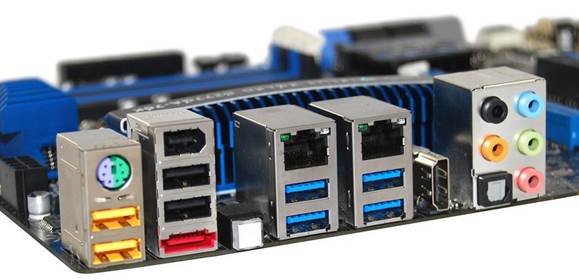I received the Intel DZ77GA - 70K as part
of my Press Kit for the Intel Ivy Bridge in 2012, so I was concerned that it
might be showing its age when I took it off the shelf and dusted it down. It
turns out I had no need for concern, as the DZ77GA-70K still packs a punch
despite a subtle shift in Intel's third-generation Core i7 product range.
The DZ77GA-70K has been replaced at the top
of Intel's LGA1155 range with the introduction of Intel DZ77RE-75K, which gains
a Thunderbolt port and costs $293. This has led to DZ77GA- 70K dropping in
price over the past year from $278 to $210, which means you're effectively
paying a $83 premium for that Thunderbolt port if you choose to buy the
DZ77RE-75K.
It's interesting to see how Intel has used
the Z77 chipset to pack this ATX motherboard with a long list of features.
There are two PCI Express 3.0 graphics slots that support either CrossFireX or
SLI and four memory slots that support up to 32GB of DDR3-1600MHZ memory. In
fact, this part of the specification is nonsense, as the Kingston HyperX Beast
DDR3-2400l\/lHz memory that I used in testing was happy to run significantly
faster than 1,600MHz.

The
DZ77GA-70K has been replaced at the top of Intel's LGA1155 range with the
introduction of Intel DZ77RE-75K, which gains a Thunderbolt port and costs
$293.
The DZ77GA-70K supports two XMP profiles
for this memory, and I could run it at either 2,133MHz or 2,400MHz without any
problems.
Intel gets around a SATA limitation of the Z77
chipset and has used an add-in controller to provide a total of four SATA 6Gbps
connectors, in addition to the four native SATA 6Gbps connectors. All eight
SATA connectors are laid down for ease of access,
On the USB 3.0 front, Intel has
acknowledged the weakness of Z77 and has refused to settle for the four native
USB 3.0 ports on the I/O panel. In addition, there are two mid-board headers
supported by Qensys controllers that provide four more USB 3.0 ports. Intel
supplies a 3.5" drive bay adapter with two of these ports, and because
there's a good chance that your case supports two USB 3.0 ports, you may well
be able to employ all eight ports.
If you have to resort to the USB 2.0 ports,
there's good news here, as the two yellow ports on the I/O panel are high power
for charging devices, while the two black ports are standard. It's a similar
story with the USB 2.0 headers, where two headers are regular items and one is
yellow to give two more high power ports.

On
the USB 3.0 front, Intel has acknowledged the weakness of Z77 and has refused
to settle for the four native USB 3.0 ports on the I/O panel.
Intel has included a Bluetooth/802.11n
module in the package that connects to a USB 2.0 mid-board header.
On the I/O panel, Intel has made a number
of choices that only leave enough space for a single HDMI output on the I/O
panel for graphics connectors for the integrated GPU. For one thing, there's a
legacy PS/2 port, and for another, there's a FireWire 400 port that is
supported by an add-in controller chip. Intel has also provided two gigabit
Ethernet ports and its Back to BIOS button
that forces the PC to boot into the BIOS setup screen if you hit a problem that
needs to be corrected. Intel doesn't make life easy when it comes to
overclocking. For one thing it doesn't make Intel XTU (Intel Extreme Tuning
Utility) available for this model. I downloaded and installed the latest
version on the off-chance it might work and I found that while it did a good
job as a system monitor, the software refused to work when I tried to change
settings and it simply crashed.

On
the I/O panel, Intel has made a number of choices that only leave enough space
for a single HDMI output on the I/O panel for graphics connectors for the
integrated GPU.
Instead, I used the Turbo Boost setting in the
UEFI Visual BIOS screen to increase the maximum speed to 4.2GHz on stock
voltages. Any higher speed made Windows Explorer crash even though there was no
load and the CPU Turbo wouldn't have been active.
With the CPU set to increase to 4.2GHz, the
system ran reliably and delivered decent performance. You get a decent list of
features with this rather expensive motherboard, but the lack of graphics
connectors and in particular the lack of overclocking tools removes some of the
appeal.
|
Details
·
Price: $210
·
Manufacturer: Intel
·
Website: www.intel.com
Ratings
·
Overall: 7
·
Quality: 8
·
Value: 6
|